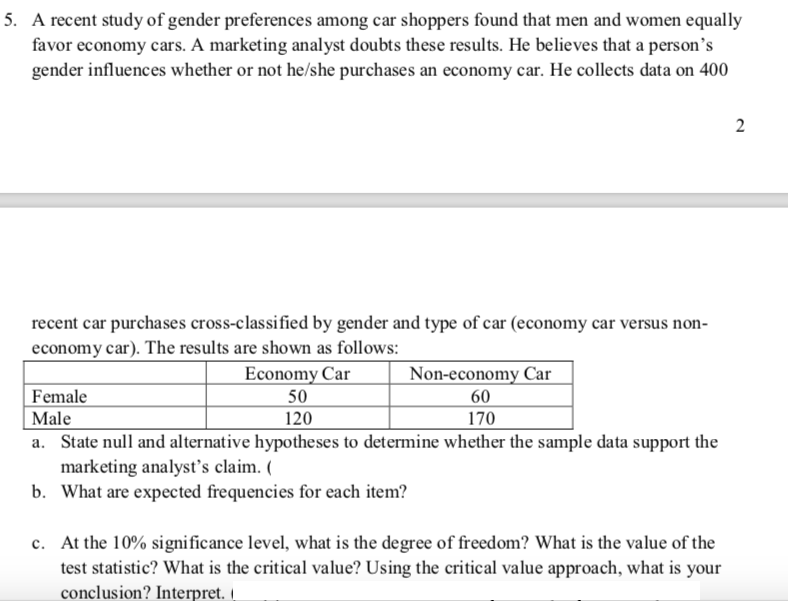5. A recent study of gender preferences among car shoppers found that men and women equally favor economy cars. A marketing analyst doubts these results. He believes that a person's gender influences whether or not he/she purchases an economy car. He collects data on 400 2 recent car purchases cross-classified by gender and type of car (economy car versus non- economy car). The results are shown as follows: Economy Car Non-economy Car Female | Male a. State null and alternative hypotheses to determine whether the sample data support the marketing analyst's claim. b. What are expected frequencies for each item?| 50 60 120 170 c. At the 10% significance level, what is the degree of freedom? What is the value of the test statistic? What is the critical value? Using the critical value approach, what is your conclusion? Interpret.
5. A recent study of gender preferences among car shoppers found that men and women equally favor economy cars. A marketing analyst doubts these results. He believes that a person's gender influences whether or not he/she purchases an economy car. He collects data on 400 2 recent car purchases cross-classified by gender and type of car (economy car versus non- economy car). The results are shown as follows: Economy Car Non-economy Car Female | Male a. State null and alternative hypotheses to determine whether the sample data support the marketing analyst's claim. b. What are expected frequencies for each item?| 50 60 120 170 c. At the 10% significance level, what is the degree of freedom? What is the value of the test statistic? What is the critical value? Using the critical value approach, what is your conclusion? Interpret.
Glencoe Algebra 1, Student Edition, 9780079039897, 0079039898, 2018
18th Edition
ISBN:9780079039897
Author:Carter
Publisher:Carter
Chapter10: Statistics
Section: Chapter Questions
Problem 13PT
Related questions
Question

Transcribed Image Text:5. A recent study of gender preferences among car shoppers found that men and women equally
favor economy cars. A marketing analyst doubts these results. He believes that a person's
gender influences whether or not he/she purchases an economy car. He collects data on 400
2
recent car purchases cross-classified by gender and type of car (economy car versus non-
economy car). The results are shown as follows:
Economy Car
Non-economy Car
Female
| Male
a. State null and alternative hypotheses to determine whether the sample data support the
marketing analyst's claim.
b. What are expected frequencies for each item?|
50
60
120
170
c. At the 10% significance level, what is the degree of freedom? What is the value of the
test statistic? What is the critical value? Using the critical value approach, what is your
conclusion? Interpret.
Expert Solution
This question has been solved!
Explore an expertly crafted, step-by-step solution for a thorough understanding of key concepts.
This is a popular solution!
Trending now
This is a popular solution!
Step by step
Solved in 3 steps with 3 images

Recommended textbooks for you

Glencoe Algebra 1, Student Edition, 9780079039897…
Algebra
ISBN:
9780079039897
Author:
Carter
Publisher:
McGraw Hill

Holt Mcdougal Larson Pre-algebra: Student Edition…
Algebra
ISBN:
9780547587776
Author:
HOLT MCDOUGAL
Publisher:
HOLT MCDOUGAL

Glencoe Algebra 1, Student Edition, 9780079039897…
Algebra
ISBN:
9780079039897
Author:
Carter
Publisher:
McGraw Hill

Holt Mcdougal Larson Pre-algebra: Student Edition…
Algebra
ISBN:
9780547587776
Author:
HOLT MCDOUGAL
Publisher:
HOLT MCDOUGAL